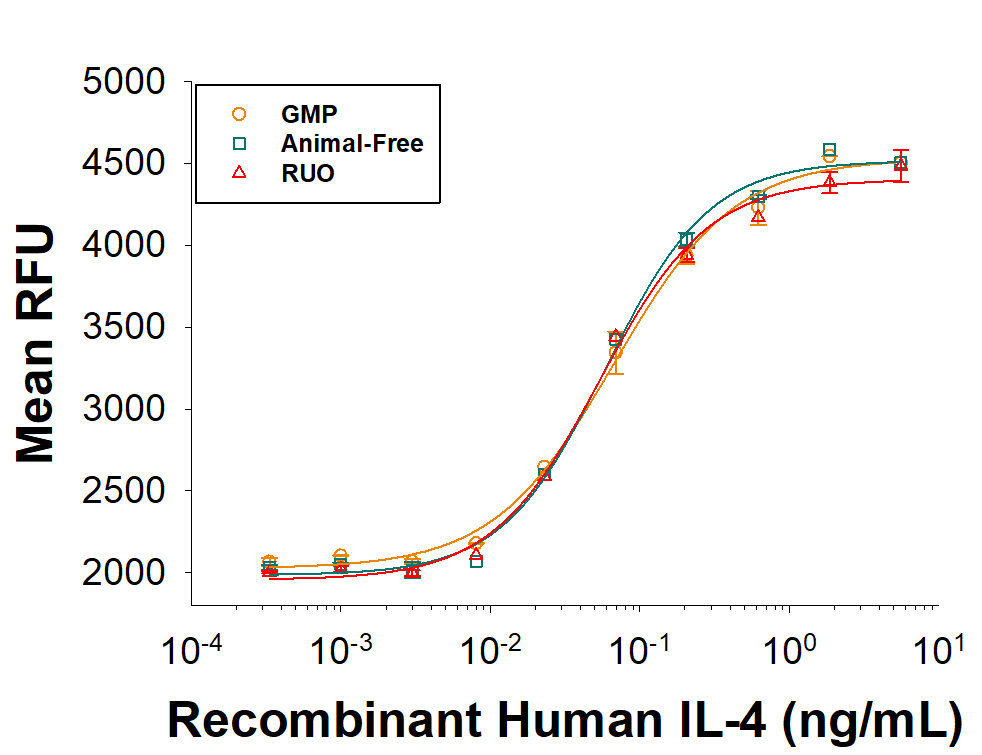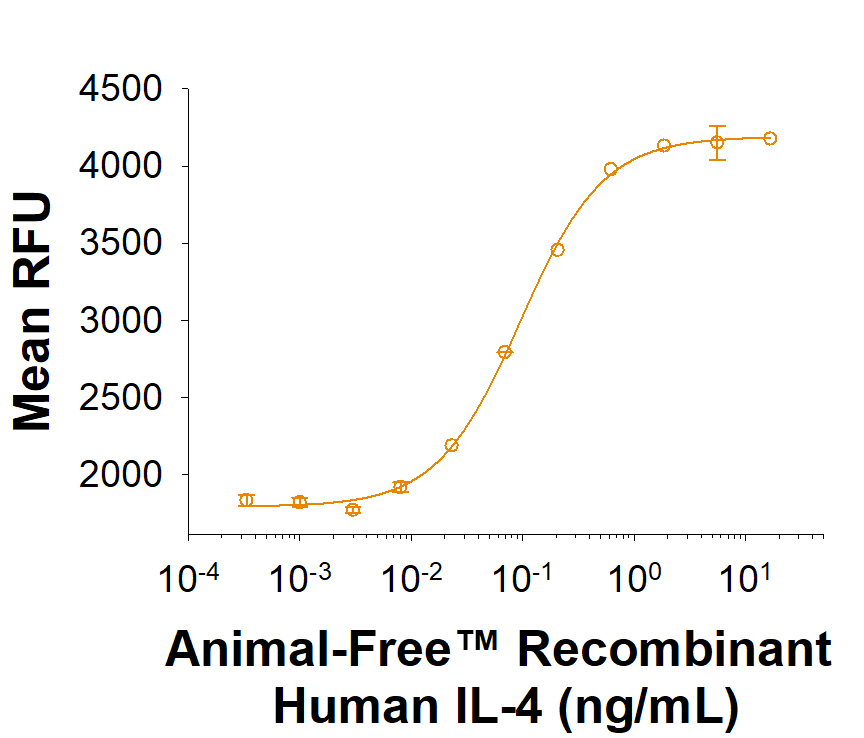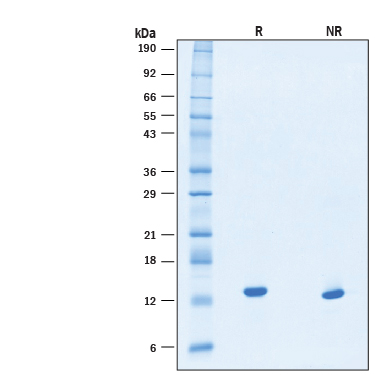Recombinant Human IL-4 Protein, Animal-Free
Recombinant Human IL-4 Protein, Animal-Free Summary
Learn more about Animal-Free Recombinant ProteinsProduct Specifications
His25-Ser153, with an N-terminal Met
Produced using non-animal reagents in an animal-free laboratory.
Analysis
Product Datasheets
Carrier Free
CF stands for Carrier Free (CF). We typically add Bovine Serum Albumin (BSA) as a carrier protein to our recombinant proteins. Adding a carrier protein enhances protein stability, increases shelf-life, and allows the recombinant protein to be stored at a more dilute concentration. The carrier free version does not contain BSA.
In general, we advise purchasing the recombinant protein with BSA for use in cell or tissue culture, or as an ELISA standard. In contrast, the carrier free protein is recommended for applications, in which the presence of BSA could interfere.
BT-004-AFL
| Formulation | Lyophilized from a 0.2 μm filtered solution in PBS with Trehalose. |
| Reconstitution | Reconstitute at 500 μg/mL in PBS. |
| Shipping | The product is shipped at ambient temperature. Upon receipt, store it immediately at the temperature recommended below. |
| Stability & Storage: | Use a manual defrost freezer and avoid repeated freeze-thaw cycles.
|
Scientific Data
 View Larger
View Larger
As an alternative, please consider our next generation Recombinant Human IL-4 Protein, (BT-004-GMP). This has equivalent bioactivity to Recombinant Human IL-4 Proteins (BT-004) and Catalog # BT-004-AFL.These combine R&D Systems quality with scalability that allows for a solid supply chain. All Recombinant Human IL-4 proteins are measured in a cell proliferation assay using TF-1 human erythroleukemic cell line.
 View Larger
View Larger
Recombinant Human IL‑4 stimulates cell proliferation of TF‑1 human erythroleukemic cells. The ED50 for this effect is 0.0400‑0.320 ng/mL.
 View Larger
View Larger
2 μg/lane of Animal-Free™ Recombinant Human IL‑4 Protein (Catalog # BT-004-AFL) was resolved with SDS-PAGE under reducing (R) and non-reducing (NR) conditions and visualized by Coomassie® Blue staining, showing bands at 13 kDa underreducing conditions.
Reconstitution Calculator
Background: IL-4
Interleukin-4 (IL-4), also known as B cell-stimulatory factor-1, is a monomeric, approximately 13 kDa‑18 kDa Th2 cytokine that shows pleiotropic effects during immune responses (1‑3). It is a glycosylated polypeptide that contains three intrachain disulfide bridges and adopts a bundled four alpha -helix structure (4). Human IL-4 is synthesized with a 24 aa signal sequence. Alternate splicing generates an isoform with a 16 aa internal deletion. Mature human IL-4 shares 55%, 39% and 43% aa sequence identity with bovine, mouse, and rat IL-4, respectively. Human, mouse, and rat IL-4 are species-specific in their activities (5‑7). IL-4 exerts its effects through two receptor complexes (8, 9). The type I receptor, which is expressed on hematopoietic cells, is a heterodimer of the ligand binding IL-4 R alpha and the common gamma chain (a shared subunit of the receptors for IL-2, -7, -9, -15, and ‑21). The type II receptor on nonhematopoietic cells consists of IL-4 R alpha and IL‑13 R alpha 1. The type II receptor also transduces IL-13 mediated signals. IL-4 is primarily expressed by Th2-biased CD4+ T cells, mast cells, basophils, and eosinophils (1, 2). It promotes cell proliferation, survival, and immunoglobulin class switch to IgG4 and IgE in human B cells, acquisition of the Th2 phenotype by naïve CD4+ T cells, priming and chemotaxis of mast cells, eosinophils, and basophils, and the proliferation and activation of epithelial cells (10‑13). IL-4 plays a dominant role in the development of allergic inflammation and asthma (12, 14).
Due to its role in the differentiation of certain immune cell types, IL-4 is commonly used in combination with other growth factors to transform induced pluripotent stem cells into dendritic cells in high numbers. These dendritic cells can then be used for research or clinical applications to improve disease modeling, for screening and cell therapies (15). Study of IL-4 signaling has led to the development of monoclonal antibodies that can block the signaling pathway at various steps to mitigate the inflammatory response in certain autoimmune diseases (16, 17). While IL-4 has the capacity to improve immune functions, treatments involving IL-4 have not been utilized due to the dangerous side effects that may result from IL-4 signaling in non-immune cells (16). Blockade of IL-4 signaling also has been studied as a therapeutic target to suppress inflammation in the tumor microenvironment (18). Use of IL-4 suppressors can also improve the efficacy of anti-tumor immunotherapies, as blocking IL-4 enhances activity of tumor-specific T lymphocytes (19, 20).
- Benczik, M. and S.L. Gaffen (2004) Immunol. Invest. 33:109.
- Chomarat, P. and J. Banchereau (1998) Int. Rev. Immunol. 17:1.
- Yokota, T. et al. (1986) Proc. Natl. Acad. Sci. 83:5894.
- Redfield, C. et al. (1991) Biochemistry 30:11029.
- Ramirez, F. et al. (1988) J. Immunol. Meth. 221:141.
- Leitenberg, D. and T.L. Feldbush (1988) Cell. Immunol. 111:451.
- Mosman, T.R. et al. (1987) J. Immunol. 138:1813.
- Mueller, T.D. et al. (2002) Biochim. Biophys. Acta 1592:237.
- Nelms, K. et al. (1999) Annu. Rev. Immunol. 17:701.
- Paludan, S.R. (1998) Scand. J. Immunol. 48:459.
- Corthay, A. (2006) Scand. J. Immunol. 64:93.
- Ryan, J.J. et al. (2007) Crit. Rev. Immunol. 27:15.
- Grone, A. (2002) Vet. Immunol. Immunopathol. 88:1.
- Rosenberg, H.F. et al. (2007) J. Allergy Clin. Immunol. 119:1303.
- Flosdorf, N. & Zenke, M. (2022) Eur. J. Immunol. 52:1880.
- Junttila, I.S. (2018) Front Immunol. 9:888.
- Keegan, A.D. et al. (2021) Fac Rev. 10:71.
- Bankaitis, K.V. & Fingleton, B. (2016) Clin. Exp. Metastasis. 32:847.
- Mirlekar, B. (2022) SAGE Open Med. 10:1.
- Ilto, S. E. et al. (2017) Cancer Immunol Immunother. 66:1485.
Manufacturing Specifications
Animal-Free Manufacturing ConditionsOur dedicated controlled-access animal-free laboratories ensure that at no point in production are the products exposed to potential contamination by animal components or byproducts. Every stage of manufacturing is conducted in compliance with R&D Systems' stringent Standard Operating Procedures (SOPs). Production and purification procedures use equipment and media that are confirmed animal-free.
Production
- All molecular biology procedures use animal-free media and dedicated labware.
- Dedicated fermentors are utilized in committed animal-free areas.
Purification
- Protein purification columns are animal-free.
- Bulk proteins are filtered using animal-free filters.
- Purified proteins are stored in animal-free containers in a dedicated cold storage room.
- Low Endotoxin Level.
- No impairment of biological activity.
- High quality product obtained under stringent conditions.
- For ex vivo research or bioproduction, additional documentation can be provided.
FAQs
No product specific FAQs exist for this product, however you may
View all Proteins and Enzyme FAQsReviews for Recombinant Human IL-4 Protein, Animal-Free
There are currently no reviews for this product. Be the first to review Recombinant Human IL-4 Protein, Animal-Free and earn rewards!
Have you used Recombinant Human IL-4 Protein, Animal-Free?
Submit a review and receive an Amazon gift card.
$25/€18/£15/$25CAN/¥75 Yuan/¥2500 Yen for a review with an image
$10/€7/£6/$10 CAD/¥70 Yuan/¥1110 Yen for a review without an image







